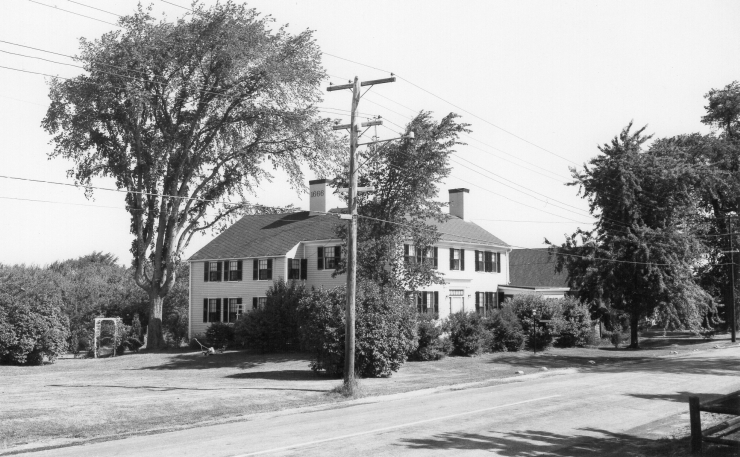Official Souvenir Program Book
January 1 – December 31, 1988
Compiled by: Mr. & Mrs. Ansell W. Palmer,
Mr. & Mrs. Stillman H. Hobbs and
Mr. & Mrs. Robert P. Gabriel
By new world standards Hampton is an old town which will be celebrating its 350th anniversary in 1988. During the three and one half centuries of its existence, housing has passed through a great many stages.
The first settlers came to a wilderness where they had to make their own habitations. They arrived at the “Landing” in a shallop October 14, 1638 and probably lived on board the boat while they built shelters for the oncoming winter.
They put aside a considerable tract of land for the Meeting House Green a short distance inland from the place of their landing. This included Ring Swamp with thc road around it. From the easterly part of the green, a common-way was also laid out.
In 1639 “house lots” were granted, radiating from the Meeting House Green and along the Common-way leading eastward. House lots in those days consisted of many acres each. Shortly afterward many more grants were made to families who came to join the original group.
Many of Hampton’s old houses are on these original house lots where the long-since gone original shelters once stood. Often, second and third houses have been built on the sites. In many cases very old houses were enlarged and enhanced at various times as the owners felt the desire or need to accommodate growing families and were financially able to do so, much of this occurring around the year 1800.
In this article we shall attempt to identify and describe several of the still standing—still occupied, fine old houses that we are very fortunate to have remaining in this town. They are living testaments to the rich heritage that Hampton enjoys and holds dear.
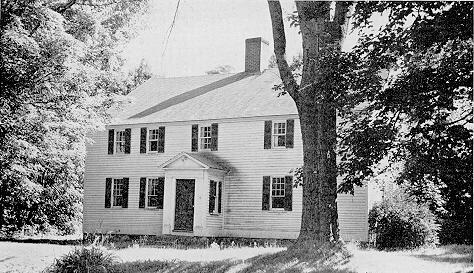
Home of Dr. and Mrs. Raymond E. Alie
The Godfrey Dearborn House
The Godfrey Dearborn house is of great interest from the architectural historian’s point of view. The original part of the house is believed to be the oldest frame dwelling in Hampton. Godfrey Dearborn first settled in Exeter. According to Joseph Dow in History of Hampton, he moved to Hampton between 1648 and 1650, and made his home where this lovely old house is located. The west side of the house was built first, probably a typical half-house with the chimney and front door as they are today. As was customary, the house was enlarged with the addition of the east side c. 1730. A house evolving in this way was not usually symmetrical. Of special interest in the interior is the paneling in the living room.
It should be noted that the area across the road from the house was known as Wigwam Row because Indians used to camp on the sheltered southern slope when they came to the coast for fish and clams.
The Samuel Lamprey Brown House
205 Winnacunnet Road
Home of Mrs. Susan Tremblay
This very attractive home was originally built c. 1810 as a “half cape.” It remained in the Brown family until 1964 when the Tremblays bought it. In 1969 an ell was built between the house and the barn, and then in 1976 the other “half’ was added to complete the charming house as it is today. Everything was well planned and done in keeping with the period of the original house as were the furnishings and decorating inside.
Many Hampton residents will remember this as the home of Edward Palmer Brown, who lived here unmarried. He was the great grandnephew of the original builder.
The Nathaniel and Sanborn Batchelder House
411 Exeter Road
Home of Mr. and Mrs. Edwin L. Batchelder, Jr.
As far as can be determined, the west side of this house was built as a half house c. 1760 and may have been moved from across the road. The east side was added in the early 1800’s. The original central chimney was removed in 1919 as were the “nine over six windows. The sun porch was added soon after. Edwin is the sixth generation to live here.
This attractive home has been tastefully renovated keeping both preservation and comfortable living in mind with the use of old boards, exposed beams, a brick oven, and a built-in boiling kettle behind the fireplace masonry.
It is remarkable and unusual that this property still has a huge barn and other farm buildings, all in excellent condition. Warren Batchelder ran a butcher business here for many years.
The Howard Garland Lane House
380 Lafayette Road
The George Woody Foss Corporate Center
When Howard and Sarah Hobbs Lane built this fine Victorian house in 1900 it must have been impressive. From the front door one enters a large reception hall with a stairway, all with original oak woodwork and paneling. The rooms on either side have cypress and poplar woodwork. The high ceilings and large windows, some with stained glass, are typical of fine houses of the period. The two rooms on the south side were the living room and dining room, each with a corner fireplace, one made of tiles and the other of beach pebbles. The corner tower is unique and must have taken a great deal of planning and building.
When Howard wanted to build this house, he bought ten acres on the west side of Lafayette Road from the Odd Fellows building to the intersection of Winnacunnet Road including the “Deacon Tuck” house which was the only house along the road at that time.
Howard and Sarah Hobbs Lane were philanthropic and charitable people, both expending a great deal of effort and their means to help others, especially children. It was Howard who donated the Lane Memorial Library to Hampton in memory of his father Joshua A. Lane. He hired the architect, had the library built, and gave it to the town complete.
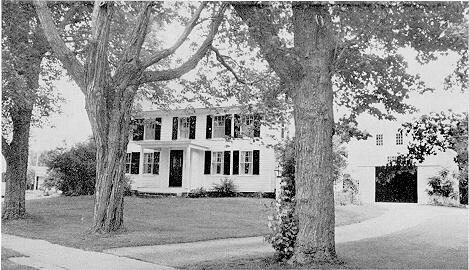
Home of Judge and Mrs. Edward J. McDermott
The John Moulton House
This gracious and comfortable home is on land granted to John Moulton at the time of the first settlement of Hampton. It has gone through many stages throughout its long history. The south front room appears to be very early with a “summer” beam overhead. The other front room also with a “summer” beam was probably added soon afterward. In 1750 there was undoubtedly an upgrading with wainscoting and flooring installed. There are five working fireplaces, two of which the McDermotts have uncovered and restored. The mantel in the office was salvaged from the Silas Gould house in Exeter before it was demolished. (The Gould house was the residence of Tad Lincoln when he attended Phillips Exeter Academy.) After a fire in 1810 the back part of the house was greatly expanded to double the space on both floors.
Eight Moultons held title to this home until 1866 when Daniel sold the place because of infirmity and moved diagonally across Winnacunnet Road to live with his nephew Enoch Palmer Young.
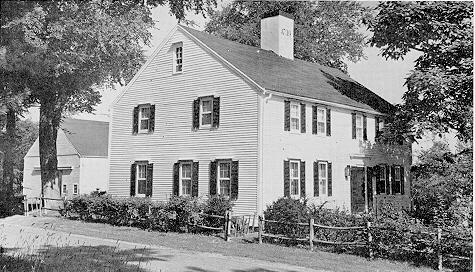
Home of Mr. and Mrs. Arnet R. Taylor
The Toppan-Towle Homestead
This fine old house is situated on the northwest corner of Lafayette and Drakeside Roads just north of the General Jonathan Moulton house. It was originally located on the Portsmouth Road a little north of the Hampton-North Hampton boundary line. It was at that time a tavern operated by the widow of Moses Leavitt. When a fire burned it to the ground in 1733 it was rebuilt by Mrs. Leavitt’s neighbors. Many years later it was moved to its present location. Shortly after the American Revolution in 1776 Captain Caleb Toppan, a wealthy Newburyport ship owner and merchant, moved to Hampton with his family. It is not known if he was the one responsible for moving the house, but it is likely that he was the one who transformed the house into a beautiful mansion. His acquaintance with Gen. Moulton many have been the reason for his relocation from Newburyport to Hampton.
After Toppan’s death his grandson, Richard Greenleaf, inherited the property and operated a store in a part of it. David Towle bought the property in the 1830’s and it remained in possession of the Towle family until the 1950’s when it was bought by Mr. and Mrs. Claude La Roux and restored to its original plan as far as was consistent with modern living.
The beautiful paneling, the delicately reeded pilastered columns flanking the fireplace in the living room, the window seats, sliding Indian shutters and folding shutters are similar to those features found in the Gen. Moulton house, further suggesting the possibility of some collaboration between Toppan and Moulton as mentioned above.

Home of Mr. & Mrs. Anthony Olbres
The General Jonathan Moulton House
This well proportioned, handsome Georgian house was built 1760-1770 to replace an earlier house which had mysteriously burned. (See story elsewhere in this book.) The ell is an earlier structure. After the fire, General Moulton built the existing house, which in the 1920’s was moved back a little so that Lafayette Road could he straightened.
This house has been faithfully restored and preserved. On entering the central hall one sees the beautiful stairway and exceptionally good, wide-board paneling. Also to be noted are the fireplaces and paneled fireplace walls in all rooms, the box locks on the doors, the old latches, and the “H” hinges. The present owners have displayed excellent taste in decorating. Appropriate furniture is evident everywhere. General Moulton would be more than pleased if he were to gaze upon his former home; and perhaps he does!
The Nathaniel Batchelder House
60 Park Avenue
Home of Mr. & Mrs. Willis Eaton
The Eatons have resided in this house since they purchased it in 1963. In renovating their home and adapting it to modern living they have retained a great many old features. The front stairway is to be noted especially, having original wide boards with beaded edges. There are four fireplaces and a brick oven. Old wide boards were used on the ceiling in the living room.
This house was rebuilt c. 1815 by John Batchelder who lived here until 1840. He was the fifth of the Batchelders to live on this site beginning with Nathaniel, who was the first of other Batchelders having the name Nathaniel. Nathaniel, born in England, was the grandson of the Rev. Stephen Bachiler who was the leader of the first settlers of Hampton and whose home was approximately opposite Nathaniel’s. John Sanborn, another grandson, lived a little to the west.
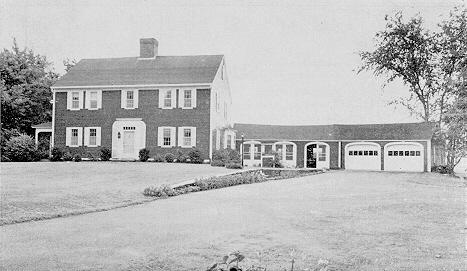
Home of Mr. & Mrs. Peter A. Stern
The Jackson-Emery House
Located on a ridge just across from Meeting House Green, this house was built in 1731 and lived in by a physician, Dr. Clement Jackson, with his wife Sarah, daughter of Thomas Leavitt. One of his children born here was Hall Jackson, who became a famous physician, noted for his ability in treating smallpox and his great success for operating on cataracts of the eye. He was recently honored by the newly-built and opened HCA Portsmouth Regional Hospital when the Jackson-Grey Medical Facility was named after him.
In 1750 Dr. Jackson sold the house to his brother-in-law, Dr. Anthony Emery, married to Abigail, Thomas Leavitt’s youngest daughter. Four generations of Emerys lived in this house.
In 1957 the Roy L. Woodworth family faithfully restored the house to its original authentic colonial condition.
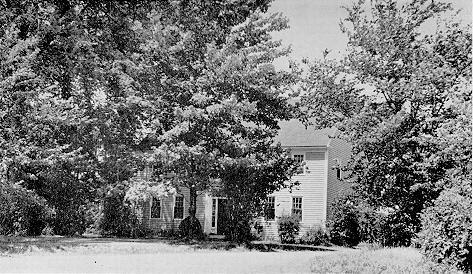
416 Winnacunnet Road
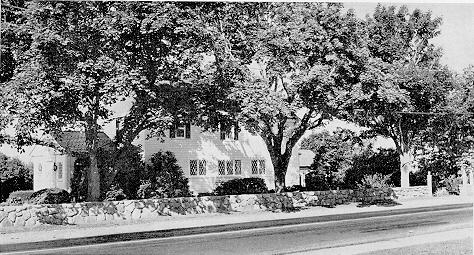
22 Exeter Road
There are many other fine old houses in Hampton, many of them built in pre-Revolutionary colonial days such as the Reuben Lamprey House at 416 Winnacunnet Road built around 1760; the Philbrick House at 22 Exeter Road built in 1763; and the Knowles House at 24 Locke Road built in 1666. Still others built in the late l700’s and in the l800’s have been maintained and are still being lived in at this date. That these houses have endured for so many years is a tribute to the skills of the workmen of those days who strove to produce a lasting product providing us with a heritage of our past.
24 Locke Road
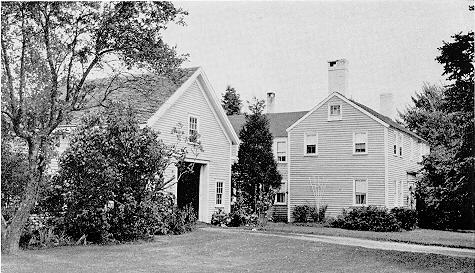
404 Winnacunnet Road
